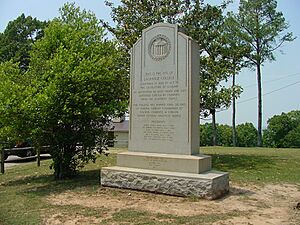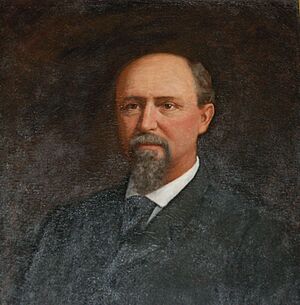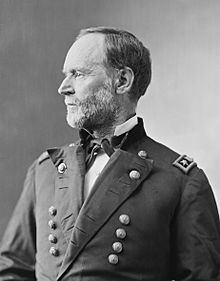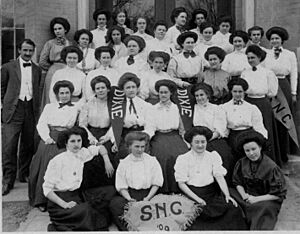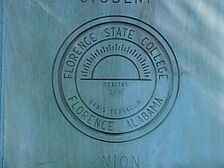History of the University of North Alabama facts for kids
The University of North Alabama (UNA) is a large university today, but it started small in the early 1800s. It began when the Methodist Episcopal Church wanted to bring education to a quiet mountain area in Alabama.
From these simple beginnings, the university grew. It went from a church school with little money to a school for teachers, then a teachers college, and finally, the state university it is now.
Contents
- LaGrange College: The Beginning
- Florence Wesleyan University: A New Home
- The Civil War: A Difficult Time
- State Normal School at Florence: Training Teachers
- State Normal College: Expanding Studies
- Florence State Teachers College: Four-Year Degrees
- Florence State College: Growing Programs
- Integration at Florence State College: A Step Forward
- Florence State University: A New Era
- The University of North Alabama: A Regional Leader
LaGrange College: The Beginning
The University of North Alabama actually started as LaGrange College. It opened on January 11, 1830, in a small mountain town near Leighton in Colbert County, Alabama. The name "LaGrange" means "The Barn" in French.
Today, a huge stone monument marks the spot where LaGrange College and its community once stood. Union soldiers burned both the town and the college in 1863 during the American Civil War. However, by then, the college had already moved north across the Tennessee River to Florence. The area where LaGrange Mountain was is now part of Colbert County. LaGrange College later became Florence Wesleyan University in 1855, and then eventually the University of North Alabama.
The idea for LaGrange College came from a meeting of the Methodist Episcopal Church in 1826. They wanted to create a college that would not be "religious or theological." By January 1829, they chose Lawrence Hill on LaGrange Mountain for the school's location.
A year later, LaGrange College opened its doors to students of all faiths. It had two three-story brick buildings. This was just over a year before the University of Alabama opened in Tuscaloosa. Eight days after LaGrange College opened, the Alabama Legislature officially approved its charter. This made it the first state-chartered school to begin operating in Alabama. Other colleges were open, but they didn't have a state charter yet.
Robert Paine was the first president. He was from North Carolina and also taught moral science, belles lettres (fine literature), geography, and mineralogy. Two other professors helped him. The first board of trustees had 50 members, including two Native Americans: a Choctaw politician and a Cherokee leader. In 1830, Turner Saunders was the first President of the Board of Trustees. His old mansion from 1826 is still standing in Lawrence County. Other important trustees included John Coffee, a friend of Andrew Jackson, and Henry Stuart Foote, who later became a governor in Mississippi. J.D. Malone was the first student to graduate in 1833.
In 1850, a grammar school was added to LaGrange College. Today, UNA still has a special elementary school called Kilby Professional Laboratory School, which is the only one owned and run by a university in Alabama.
Many important people graduated from LaGrange, including several generals, Alabama governors Edward A. O'Neal and David P. Lewis, Alabama Supreme Court justice William M. Byrd, and U.S. Senator Jeremiah Clemens. Clemens wrote the first American Civil War novel and the first western novel.
Florence Wesleyan University: A New Home
In late 1854, LaGrange graduate R.H. Rivers became the college president. He led most of the students and nearly all the teachers from the mountain to relocate to Florence.
Everyone expected the school to keep the name LaGrange College after the move. However, the Alabama Legislature passed a bill to give the school a new name: Florence Wesleyan University. Even though Governor John A. Winston tried to stop it, the Alabama Legislature voted to override his veto.
| President | Years |
|---|---|
| Robert Paine | 1830–1846 |
| Edward Wadsworth | 1847–1852 |
| James Ward Hardy | 1852–1853 |
| Smith W. Moore (Acting) | 1853 |
| R. H. Rivers | 1854–1861 |
| Robert A. Young | 1862–1865 |
| Septimus P. Rice (Acting) | 1865–1868 |
| William H. Anderson | 1868–1871 |
| Transition Period | 1872–1873 |
| Septimus P. Rice | 1873–1881 |
| Hardie A. Brown | 1881–1885 |
| James A. Heard | 1885–1886 |
| T. J. Mitchell | 1886–1887 |
| James Knox Powers | 1887–1897 |
To get into Florence Wesleyan, students needed to know English grammar, arithmetic, geography, and Latin and Greek Grammar. They also had to be able to translate certain classical texts.
In its first year (1855), 160 students enrolled at Florence Wesleyan University. The school quickly attracted students from five states and two other countries. Some famous graduates include Alabama Governor Emmet O'Neal and Texas Governor Lawrence Sullivan "Sul" Ross. Ross later became president of Texas A&M University, a time known as its "golden age." Sul Ross University in Alpine, Texas is named after him.
The years just before the Civil War were the best for the school in the 1800s. The new university had no debt and even saved $50,000. The teachers were considered excellent for that time and place.
The Civil War: A Difficult Time
The American Civil War caused many problems for the school. After the attack on Fort Sumter in 1861, and President Lincoln asked for soldiers, four professors and over one hundred students left the school to join the fighting.
During the war, Wesleyan Hall, which was the university's only building, was used by both Union and Confederate armies.
General William Tecumseh Sherman is the most famous Union officer to have stayed in Wesleyan Hall during the war. In late 1864, Confederate General John Bell Hood also used the building. His troops camped nearby, and the grounds became a place for parties and concerts for soldiers and townspeople. Confederate Generals Pierre G.T. Beauregard and Stephen D. Lee also used the nearby grounds and might have used Wesleyan Hall as their headquarters.
Robert A. Young, who was president of Florence Wesleyan at the time, is given credit for saving the school from being destroyed.
Besides Lawrence "Sul" Ross, who was a general in the Confederate Army, LaGrange College and Florence Wesleyan University also produced three other Civil War generals: Confederate Generals Edward A. O'Neal (who later became an Alabama governor) and John Gregg, and Union General Daniel McCook, Jr..
After the war, Septimus Rice was the only teacher at the university. He taught classes for younger students and college-level courses in Wesleyan Hall. Even with efforts from the new president, William H. Anderson, the school struggled. In 1871, Wesleyan Hall closed its doors.
Recognizing the need for trained teachers in the South after the war, the Methodist Episcopal Church gave Wesleyan Hall and its surrounding 12-acre (49,000 m2) of land to the state of Alabama. The state then made it a state normal school (a school for training teachers).
State Normal School at Florence: Training Teachers
When the Methodist Church gave Florence Wesleyan to the State of Alabama in 1872, the school became the State Normal School at Florence. This was the first state-supported teachers college south of the Ohio River. Students could attend for free if they promised to teach for two years in any Alabama public school after graduating.
A year after becoming a state school, it started accepting women. This made it one of the first co-educational (for both boys and girls) schools in the country. However, no women attended until 1874, when 31 young women enrolled. The first woman joined the teaching staff in 1879.
In 1892, Newton W. Bates, a professor at Florence Normal School, published his History of Civil Government of Alabama. This was the first textbook about the history of Alabama.
State Normal College: Expanding Studies
In 1888, the school's name changed from State Normal School to State Normal College. That same year, James Knox Powers, a Florence native and former student, became the fifth president.
When Powers started, the college offered three main courses of study:
- An elementary course to prepare teachers for primary and elementary schools.
- An advanced course, which added an extra year of academic and professional subjects.
- A professional course for high school graduates and educated people who had no previous teacher training.
By 1897, when Powers left to become president of the University of Alabama, the campus hadn't changed much. Wesleyan Hall was still the only building the college owned, and the campus was still the original 12 acres (49,000 m2).
T.S. Stribling, one of the university's most famous former students, graduated from Florence State Normal School in 1903. He is known as a leader of the Southern Renaissance for his novels like Birthright, The Forge, The Store, and Unfinished Cathedral. This Pulitzer prize-winning writer even sold more books than famous authors like William Faulkner and Ernest Hemingway in the 1920s and 1930s.
Florence State Teachers College: Four-Year Degrees
| Name | Years |
|---|---|
| Marshall C. Wilson | 1897–1911 |
| James Knox Powers | 1911–1913 |
| Robert Harrison (Acting) | 1913 |
| Henry J. Willingham | 1913–1938 |
| James Albert Keller | 1938–1948 |
| F. E. Lund (Acting) | 1948 |
| Ethelbert B. Norton | 1948–1972 |
| Robert M. Guillot | 1972–1989 |
| Robert L. Potts (Acting) | 1990 |
| Robert L. Potts (Permanent) | 1990–2004 |
| G. Garry Warren (Acting) | 2004–2005 |
| William G. Cale, Jr. | 2005–2014 |
| John G. Thornell (Interim) | 2014–2015 |
| Kenneth D. Kitts | 2015–present |
The school worked as a normal school for over 50 years. Then, in 1929, it became a state teachers college. This meant it offered a four-year program in elementary education.
The first bachelor's degrees were given out in 1931. Less than ten years later, the school also offered a four-year program for teaching in high schools. In 1947, the programs expanded again to include degrees in subjects other than just teacher training.
Florence State College: Growing Programs
The school continued to grow into the comprehensive university it is today. In 1956, it reached another important step by starting a graduate program in education, leading to a Master of Arts degree. This new graduate program began in the summer of 1957. That same year, the Alabama Legislature voted to change the school's name to Florence State College. This new name showed that its academic mission was growing beyond just teaching.
Integration at Florence State College: A Step Forward
Compared to other southern universities, like the Universities of Alabama and Mississippi, integration happened much more smoothly at Florence State College.
In 1963, Wendell Wilkie Gunn became the first African-American student to enroll at the college. Gunn, who lived in Florence, had been attending Tennessee A&I but couldn't afford the tuition and living costs anymore. He applied to Florence State College so he could live at home while studying. Even though the college president and staff supported Gunn, Florence State College denied his application. President E.B. Norton sent Gunn a letter saying the Alabama Legislature and Board of Education would not let the college accept him.
U.S. District Court Judge H.H. Grooms heard a lawsuit about this. The court decided there was no reason to stop Gunn from being accepted except for his race. So, the court ordered the school to accept Gunn. He graduated with a degree in chemistry two years later.
In 2005, famous civil rights lawyer Fred Gray, who represented Gunn, spoke at UNA. He remembered that the court hearing to integrate UNA lasted only ten minutes. After that, Gunn returned to campus and enrolled. Gray called it "the easiest case of my civil rights career." Florence State College was the second state-supported higher education school in Alabama to integrate, after the University of Alabama.
Gunn later earned more degrees from Florence State College and the University of Chicago. He had a successful career in finance and was even appointed an international trade adviser to President Ronald Reagan in 1982.
Florence State University: A New Era
Another big step happened in 1967 when the Alabama Legislature gave control of the college to a board of trustees instead of the State Board of Education. Just a year later, the new board voted to change the name again to Florence State University. This name change again showed how much the school's academic programs and mission were expanding.
President Norton, who was leading the university when this name was adopted, is the only president in the school's history to oversee three name changes: Florence State Teachers College, then Florence State College in 1957, and then Florence State University about ten years later.
This name change also happened during the biggest growth in the school's physical buildings. Over 30 acres (120,000 m2) of land were added to the campus in the late 1960s. New buildings included the ten-story Rivers Hall dormitory for men and the eight-story Rice Hall for women. Other buildings completed during this time were an addition to Collier Library, the Lurleen Burns Wallace Fine Arts Center, Lafayette and LaGrange Halls, Floyd Hall Science Building, the Planetarium/Observatory, apartments for married students, the Bennett Infirmary, physical education facilities, and Flowers Hall.
These changes also came with a big reorganization of how the university was run, including creating separate schools within the university.
The University of North Alabama: A Regional Leader
| Name | Year |
|---|---|
| LaGrange College | 1830 |
| Florence Wesleyan University | 1855 |
| State Normal School at Florence | 1872 |
| State Normal College | 1889 |
| State Normal School | 1913 |
| Florence State Teachers College | 1929 |
| Florence State College | 1957 |
| Florence State University | 1968 |
| University of North Alabama | 1974 |
Robert M. Guillot became president on April 1, 1972, after E.B. Norton left. Guillot promised to turn the small school into a respected regional university. What followed was one of the most important periods of growth in the school's history. The number of students grew from just over 3,000 to more than 5,000 in less than five years.
Guillot also started a Greek system (fraternities and sororities) on campus. He believed these groups would make the academic and social environment better and encourage more students to stay on campus on weekends.
On August 15, 1974, the university changed its name again to the University of North Alabama. This name showed that it had become a complete, regional university. The next year, the graduate programs expanded again with a master's degree program in business administration.
Guillot also led a big expansion of the university's buildings. This included building the Education and Nursing Building (now Stevens Hall), adding to Collier Library, Flowers Hall, and the Student Union Building (later renamed Guillot University Center), and renovating Braly Municipal Stadium.
After a reorganization in 1991, the university's administration was divided into four main parts: Academic Affairs, Business Affairs, Student Affairs, and Advancement. Each part was led by a vice president. In 1993, the Board of Trustees expected continued student growth. They adopted a new plan for facilities to make sure UNA could eventually hold 10,000 students.
Robert L. Potts became president after Guillot resigned in 1989. Potts took steps to make up for less money from the state. This included restarting the UNA Foundation, which is the university's charity group. Other steps included reorganizing the alumni relations department and starting an annual giving program.
The school continued to add new programs, like graduate programs in English and criminal justice. The university's well-known commercial music program got better with the creation of an Entertainment Development Center. UNA also became an early leader in distance learning (online classes).
The number of international students also grew very quickly. By 2004, nearly 300 international students from 35 countries were enrolled.
William G. Cale Jr. became president of the University of North Alabama on January 15, 2005. This was just four days after the university celebrated its 175th anniversary since it was founded as LaGrange College. Cale came to UNA from Pennsylvania State University-Altoona. Before that, he was an executive vice president at Lamar University in Beaumont, Texas.
After an interim period with John G. Thornell as president, Kenneth D. Kitts became president in 2015. Kitts was previously a provost at the University of North Carolina at Pembroke. He also taught at other universities like Francis Marion University, the University of South Carolina, and Appalachian State University.


